Fuel Tank Replacement Right
Removal Procedure
Tools Required
| • | J 37088-A Tool
Set, Fuel Line Quick Connect Separator |
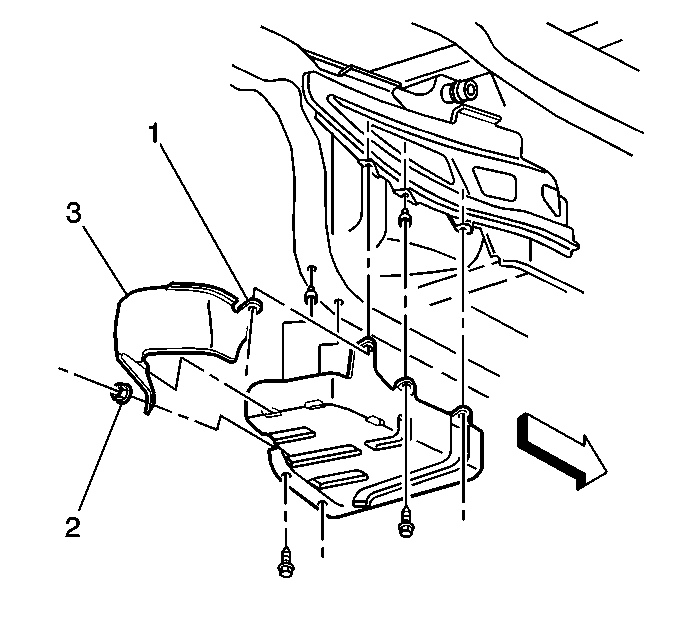
Caution: Unless directed otherwise, the ignition and start switch must be in the OFF or LOCK position, and all electrical loads must be OFF before servicing
any electrical component. Disconnect the negative battery cable to prevent an electrical spark should a tool or equipment come in contact with an exposed electrical terminal. Failure to follow these precautions may result in personal injury and/or damage to
the vehicle or its components.
- Disconnect
the negative battery cable.
- Relieve the fuel system pressure. Refer to the
Fuel Pressure Relief
.
- Drain the fuel tanks. Refer to
Fuel Tank Draining
.
- Raise the vehicle. Refer to
Lifting and Jacking the Vehicle
in General Information.
- Remove the right rear tire and wheel. Refer to
Tire and Wheel Removal and Installation
in Tires
and Wheels.
- Remove the right muffler (auto trans equipped vehicles only).
Refer to
Muffler Replacement
in Engine Exhaust.
- Remove the fuel tank shield mount nut (2).
- Remove the fuel tank shield mount bolt (1).
- Remove the fuel tank shield (3).

- Disconnect the fuel sender
electrical connector.
- Mark or identify each fuel pipe in order to aid in installing
the pipes in their original positions.
- Disconnect the fuel sender fuel feed pipe (1) (jet pump to left
tank) and the fuel feed rear crossover pipe (2) (left tank to jet pump) at
the fuel sender. Refer to
Metal Collar Quick Connect Fitting Service
or
Plastic Collar Quick Connect Fitting Service
.
- Cap the fuel pipes in order to prevent possible fuel system contamination.
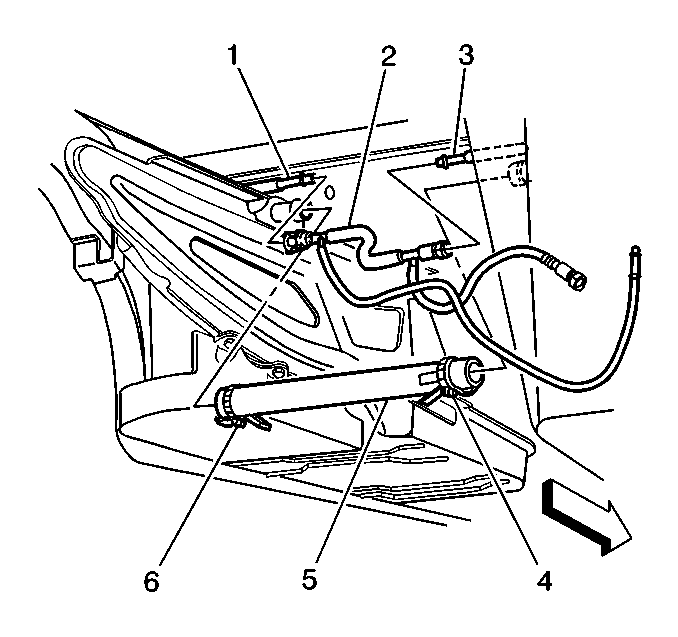
- Disconnect the tank crossover
hose (5).
- Disconnect the fuel tank vapor pipe (2) quick connect fitting
at the right fuel tank vapor pipe (3).
- Cap the fuel tank vapor pipe in order to prevent possible contamination.
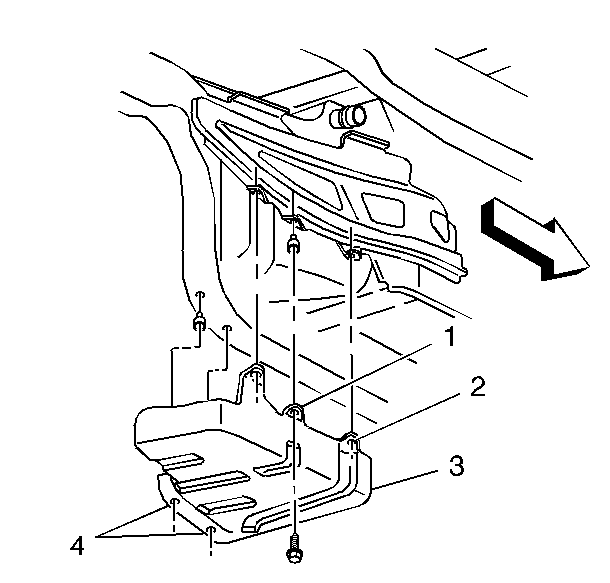
- Remove the fuel tank strap
mount bolts.
- Remove the fuel tank strap (3).
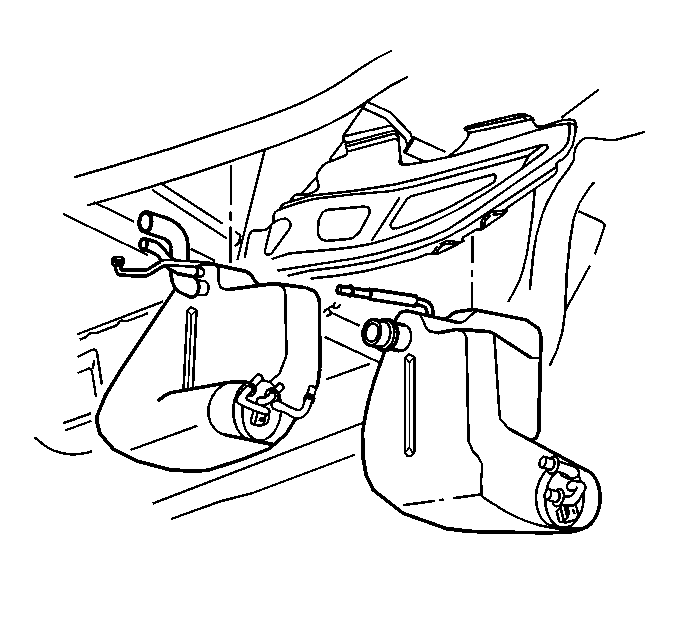
- Remove the fuel tank.
Installation Procedure
Important: Always replace the fuel system hose clamps with the original equipment
or parts that meet the GM specifications for those parts when replacing the
clamps.

- Install the fuel tank.

- Install the fuel tank
strap (3).
Notice: Use the correct fastener in the correct location. Replacement fasteners
must be the correct part number for that application. Fasteners requiring
replacement or fasteners requiring the use of thread locking compound or sealant
are identified in the service procedure. Do not use paints, lubricants, or
corrosion inhibitors on fasteners or fastener joint surfaces unless specified.
These coatings affect fastener torque and joint clamping force and may damage
the fastener. Use the correct tightening sequence and specifications when
installing fasteners in order to avoid damage to parts and systems.
- Install the fuel tank strap bolts (1, 2, 4).
Tighten
- Tighten bolt (2) to 25 N·m (18 lb ft).
- Tighten bolt (1) to 25 N·m (18 lb ft).
- Tighten the remaining bolts (4) to 25 N·m (18 lb
ft).

- Remove the cap from the
fuel tank vapor pipe.
- Connect the fuel tank vapor pipe (2) quick connect fitting at
the right fuel tank vapor pipe (3).
- Connect the tank crossover hose (5).
- Push the clamp (4) outboard against the fuel tank keeping the
clamp parallel with the white stripe on the tank crossover hose.
Tighten
Tighten the tank crossover hose clamp to 4 N·m (35 lb in).

- Remove the caps from the
fuel pipes.
- Connect the fuel sender fuel feed pipe (1) (jet pump to left tank)
and the fuel feed rear crossover pipe (2) (left tank to jet pump). Refer to
Metal Collar Quick Connect Fitting Service
or
Plastic Collar Quick Connect Fitting Service
.
- Connect the fuel sender electrical connector.

- Install the fuel tank
shield (3).
- Install the fuel tank shield mount bolt (1).
- Install the fuel tank shield mount nut (2).
Tighten
| • | Tighten the fuel tank shield mount bolt to 25 N·m
(18 lb ft). |
| • | Tighten the fuel tank shield mount nut to 25 N·m
(18 lb ft). |
- Install the right muffler (auto trans equipped vehicles only).
Refer to
Muffler Replacement
in Engine Exhaust.
- Install the right rear tire and wheel. Refer to
Tire and Wheel Removal and Installation
in Tires
and Wheels.
- Lower the vehicle.
- Refill the fuel system.
- Connect the negative battery cable.
- Inspect for leaks.
| 19.1. | Turn the ignition switch ON for 2 seconds. |
| 19.2. | Turn the ignition switch OFF for 10 seconds. |
| 19.3. | Turn the ignition switch ON. |
| 19.4. | Check for fuel leaks. |
- Program the transmitters. Refer to
Transmitter Programming/Synchronization
in Keyless Entry.
- Perform the idle learn procedure. Refer to PCM Idle Learn Procedure
.
Fuel Tank Replacement Left
Removal Procedure
Tools Required
| • | J 37088-A Tool
Set, Fuel Line Quick Connect Separator |

Caution: Unless directed otherwise, the ignition and start switch must be in the OFF or LOCK position, and all electrical loads must be OFF before servicing
any electrical component. Disconnect the negative battery cable to prevent an electrical spark should a tool or equipment come in contact with an exposed electrical terminal. Failure to follow these precautions may result in personal injury and/or damage to
the vehicle or its components.
- Disconnect
the negative battery cable.
- Relieve the fuel system pressure. Refer to the
Fuel Pressure Relief
.
- Drain the fuel tanks. Refer to
Fuel Tank Draining
.
- Raise the vehicle. Refer to
Lifting and Jacking the Vehicle
in General Information.
- Remove the left rear tire and wheel. Refer to
Tire and Wheel Removal and Installation
in Tires
and Wheels.
- Remove the left muffler (auto trans equipped vehicles only). Refer
to
Muffler Replacement
in
Engine Exhaust.
- Remove the left rear wheelhouse panel. Refer to
Wheelhouse Panel Replacement
in Body Rear End.
- Disconnect the fuel fill hose (3) and the vent hose (4).
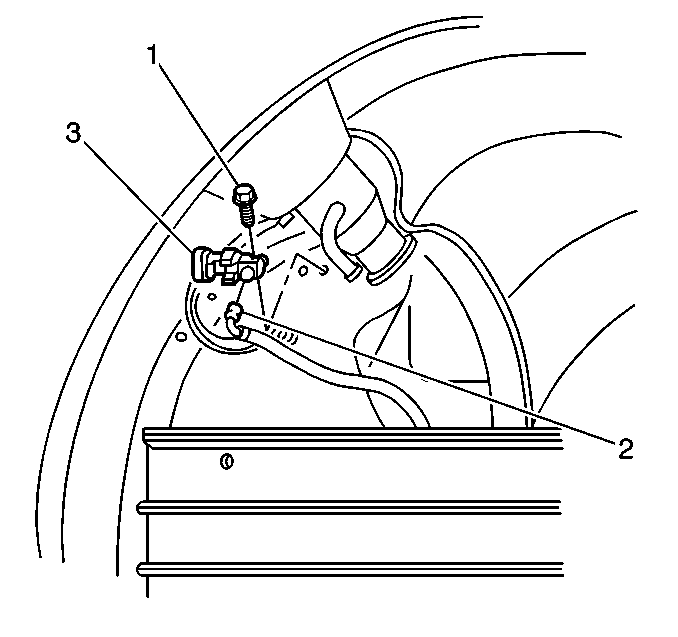
- Disconnect the EVAP pipe
(2) from the fuel pressure sensor (3).

- Remove the fuel tank shield
mount nut (2).
- Remove the fuel tank shield mount bolt (1).
- Remove the fuel tank shield (3).

- Disconnect the fuel sender
electrical connector.
- Mark or identify each fuel pipe in order to aid in installing
the pipes in their original positions.
- Disconnect the fuel sender fuel feed pipe (1) (jet pump to left
tank), the fuel return rear pipe (2), and the fuel feed rear pipe (3) at the
fuel sender. Refer to
Metal Collar Quick Connect Fitting Service
or
Plastic Collar Quick Connect Fitting Service
.
- Cap the fuel pipes in order to prevent possible fuel system contamination.

- Disconnect the tank crossover
hose (5).
- Disconnect the fuel tank vapor pipe (2) quick-connect fitting
at the left fuel tank vapor pipe (1).
- Cap the fuel tank vapor pipe in order to prevent possible contamination.

- Remove the fuel tank strap
mount bolts.
- Remove the fuel tank strap (3).

- Remove the fuel tank.
Installation Procedure
Important: Always replace the fuel system hose clamps with the original equipment
or parts that meet the GM specifications for those parts when replacing the
clamps.

- Install the fuel tank.

- Install the fuel tank
strap (3).
Notice: Use the correct fastener in the correct location. Replacement fasteners
must be the correct part number for that application. Fasteners requiring
replacement or fasteners requiring the use of thread locking compound or sealant
are identified in the service procedure. Do not use paints, lubricants, or
corrosion inhibitors on fasteners or fastener joint surfaces unless specified.
These coatings affect fastener torque and joint clamping force and may damage
the fastener. Use the correct tightening sequence and specifications when
installing fasteners in order to avoid damage to parts and systems.
- Install the fuel tank strap bolts (1, 2, 4).
Tighten
- Tighten bolt (2) to 25 N·m (18 lb ft).
- Tighten bolt (1) to 25 N·m (18 lb ft).
- Tighten the remaining bolts (4) to 25 N·m (18 lb
ft).

- Remove the cap from the
fuel tank vapor pipe.
- Connect the fuel tank vapor pipe (2) quick-connect fitting at
the left fuel tank vapor pipe (1).
- Install the tank crossover hose (5).
- Push the clamp outboard against the fuel tank keeping the clamp
parallel with the white stripe on the tank crossover hose.
Tighten
Tighten the tank crossover hose clamp to 4 N·m (35 lb in).

- Remove the caps from the
fuel pipes.
- Connect the fuel sender fuel feed pipe (1) (jet pump to left tank),
the fuel return rear pipe (2), and the fuel feed rear pipe (3). Refer to
Metal Collar Quick Connect Fitting Service
or
Plastic Collar Quick Connect Fitting Service
.
- Connect the fuel sender electrical connector.

- Install the fuel tank
shield (3).
- Install the fuel tank shield mount bolt (1).
- Install the fuel tank shield mount nut (2).
Tighten
| • | Tighten the fuel tank shield mount bolt to 25 N·m
(18 lb ft). |
| • | Tighten the fuel tank shield mount nut to 25 N·m
(18 lb ft). |

- Connect the EVAP pipe
(2) to the fuel pressure sensor (3).

- Connect the fuel fill
hose (3) and the vent hose (4).
Tighten
Tighten the fuel fill hose clamp and the vent hose clamp to 4 N·m
(35 lb in).
- Install the left rear wheelhouse panel. Refer to
Wheelhouse Panel Replacement
in Body Rear End.
- Install the left muffler (auto trans equipped vehicles only).
Refer to
Muffler Replacement
in
Engine Exhaust.
- Install the left rear tire and wheel. Refer to
Tire and Wheel Removal and Installation
in Tires
and Wheels.
- Lower the vehicle.
- Refill the fuel system.
- Connect the negative battery cable.
- Inspect for leaks.
| 22.1. | Turn the ignition switch ON for 2 seconds. |
| 22.2. | Turn the ignition switch OFF for 10 seconds. |
| 22.3. | Turn the ignition switch ON. |
| 22.4. | Check for fuel leaks. |
- Program the transmitters. Refer to
Transmitter Programming/Synchronization
in Keyless Entry.
- Perform the idle learn procedure. Refer to PCM Idle Learn Procedure
.
























